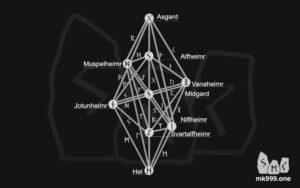Rune Ansuz — The Rune of Knowledge
Rune Ansuz — The Rune of Knowledge

Ansuz is the rune of informational flow, traditionally named “mouth of the river”, a place where one stream flows into another, symbolizing the mixing of water currents of information.
Ansuz is associated with the god Odin, who brought the runes to different worlds. This rune suits his nature, his programming, his character, and his mission perfectly. Odin was known for his long memory. The rune Ansuz represents this quality.
Ansuz is essential for ascending to a level of authority, for a warrior to become a ruler. It embodies a specific quality of consciousness that makes a person outstanding.
The Yggdrasil tree provides understanding of this consciousness. The two worlds that Ansuz connects are Jotunheim and Asgard.

Asgard is the world of laws, the fundamental Order, where all algorithms of governance are formed.
The core of the system resides in Asgard, which must be protected and validated by rights, indicated by the rune Gebo. The laws also affect the Fire worlds, defining which channels, in what volume and power will flow into this world, what ideologies will be invested here, what egregores will form, and which should wait. This information influences the world of Vanaheim, determining what the future should be like. Today’s laws suggest that tomorrow will be somewhat predictable.
Ansuz states that laws should affect not only the future but also the past. How to formulate future laws if you do not control the past? After all, the past contains all mistakes, experiences, and the experiences of others who tried to apply the same laws.
Asgard is also linked with Niflheim — to gather information and work with constants, understanding what kind of future you would like to create and what laws we need.
Jotunheim
Jotunheim is the world of ancient, continuous memory. There is no separation between good/bad, necessary/unnecessary, right/wrong; everything exists and has a right to exist. Memory is immortal, as are the ancient giants. The inhabitants of this world had a paradoxical appearance — they could be incredibly beautiful and simultaneously grotesquely ugly. This indicates that any information born and preserved in Jotunheim has a dual nature.
They have different laws, saying, “everything that appears here will always find its place.” But only your own kind can correctly understand your nature. Therefore, the nature of all jotuns is that of shapeshifters. They can appear in any form. For example, information that we accept into our inner world can be labeled “bad” or “good,” and only a developed consciousness, which has the dual, mercurial nature of Odin, can see the same information from both good and bad sides. If a person’s consciousness has such a feature, then they earn the right to power.
Qualities of the rune Ansuz
The rune Ansuz awakens another important quality in us — the ability to analyze, to extract the main points from various sources and subsequently combine these main points with each other to create something third, something unique, an element of novelty. All laws are built on this effect.
The rune Ansuz must pull human consciousness from Midgard towards the fundamental Order.
Ansuz is the opportunity to extend beyond one’s own life and death, to pass through the Tradition and Freedom and reach the structure of Order, meaning to apply past information to global laws that will influence not only today but tomorrow as well. Those who can do this become leaders of pantheons. We’re speaking not just about people, but also about gods, though it projects onto humans just as well.
Existential volume becomes heavy enough to dictate terms to today’s and tomorrow’s world. God Odin used this right when he pledged his eye, agreeing to not see the world directly as it is.
For example, we reason: if a person did something bad, they are bad. If someone did something good, they are good. By losing such primitive sight, we begin to see a bit further and deeper. A person committed a bad act according to today’s laws, but tomorrow that act leads to positive effects. Is that person bad? Today a person performed a very good deed, for instance, saved someone, but tomorrow that person they saved went and killed a neighbor. Is that person good? Thus, with the logic provided by the rune Ansuz, you look not just at the current moment but at the effect it will have.
Odin — a great god, knew how to act differently. He saw what result he needed to achieve and was not inhibited about reaching the result. He had a vast arsenal of tools to achieve results, and he would use any of them. He said, “The main thing is the result.” It’s not that the end justifies the means, we don’t formulate it like that at this level, we say: “The main thing is to achieve the result.” Victors are not judged, but the loser loses everything.
Course textbook: “Runes Reveal the Mysteries of the World”
Additional information: